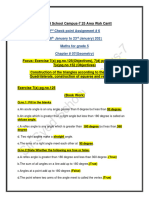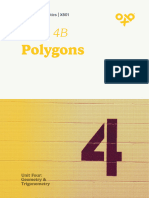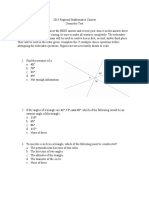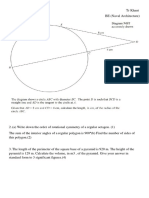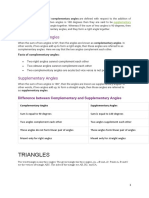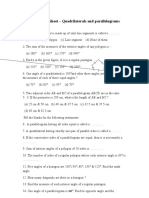F2 CH 13 Angles
F2 CH 13 Angles
Uploaded by
seyka4Copyright:
Available Formats
F2 CH 13 Angles
F2 CH 13 Angles
Uploaded by
seyka4Original Title
Copyright
Available Formats
Share this document
Did you find this document useful?
Is this content inappropriate?
Copyright:
Available Formats
F2 CH 13 Angles
F2 CH 13 Angles
Uploaded by
seyka4Copyright:
Available Formats
13 Angles of a polygon 99
13 Angles of a polygon
You should know about the sum of angles around a point, on a line and in a triangle.
This work will help you use the interior and exterior angles of a regular or irregular polygon.
You need a pair of compasses and an angle measurer.
A regular polygon is one that has all its angles and all its sides equal.
Follow these instructions to draw a regular hexagon inside a circle.
A Angles of a regular polygon
Join the vertices of the hexagon to the centre.
How many of these angles are there at the centre?
What must the sum of these angles be?
So how big is each of the angles? Check by measuring.
A1 For a regular pentagon you need five points spaced
equally around a circle.
(a) When lines are drawn from the points to the centre of
the circle, how many angles are there at the centre?
(b) What must these angles add up to?
(c) Work out the size of one angle at the centre.
A2 Copy and complete this table.
A3 Use your table from A2 to draw each of the regular polygons in a 6cm radius circle.
Use an angle measurer to draw the angles at the centre.
Regular polygon Pentagon Hexagon Octagon Decagon Dodecagon
Number of sides 5 6 8 10 12
Angle at the centre
T
Draw a circle of
radius 6cm.
Mark a point on
the circle and two
spaced 6cm each side.
Repeat, using each
mark as the centre
for another mark.
Join the marks up
to make a hexagon.
Each of these lines is a radius of the circle (plural radii).
?
100 13 Angles of a polygon
You should have found that in a regular polygon each angle at the centre is 360 ) n,
where n is the number of sides of the polygon.
You can use this fact to find the interior angles in a regular polygon.
This is part of a regular pentagon with centre O.
So the interior angle ABC is 108.
Because the pentagon is regular,
all the interior angles are 108.
A4 Copy this table and use the approach above to complete it.
Measure the interior angles of the polygons you drew in A3 and see
how well they correspond to these answers.
A5 In this question you will use the table you completed for A4.
So first make sure that it is correct.
(a) Three regular hexagons will fit exactly round a point.
Explain why.
(b) Now decide whether each of these combinations of shapes
will fit exactly round a point, giving a reason in each case.
(i) Three regular octagons
(ii) Six equilateral triangles
(iii) Two regular octagons and a square
(iv) A regular octagon, a regular hexagon and a regular pentagon
(v) Two regular hexagons and two equilateral triangles
(vi) Two regular dodecagons and an equilateral triangle
(vii) Two regular decagons and a regular pentagon
(viii) Two regular pentagons and a regular decagon
Regular polygon Pentagon Hexagon Octagon Decagon Dodecagon
Size of interior angle 108
108
A
B
C
A
B
C
O
This angle at the centre is 360 ) 5 = 72.
By the same reasoning in triangle OBC, this angle is also 54.
This triangle is isosceles (because
OA and OB are both radii of a circle).
These angles add up to 180 72 = 108
(angles of a triangle add up to 180).
But they are equal, so they are each 54.
13 Angles of a polygon 101
A quadrilateral is a shape
with four straight sides.
A quadrilateral can be
divided into two triangles.
The sum of the angles in
each triangle is 180.
The angles of the two triangles
make up the interior angles of the
quadrilateral. So the interior angles
of a quadrilateral add up to 360.
B Interior angles of a quadrilateral
B1 (a) What do these three angles add up to?
(b) What must the fourth angle of the quadrilateral be
to make all four angles add up to 360?
B2 ABCD is a quadrilateral.
Work out the value of a.
AQA
B3 Find the angles labelled by letters in these quadrilaterals.
B4 This diagram shows a kite.
(a) What is angle f ?
Explain how you know.
(b) Calculate angle g.
125
c
84 d
e
122
94
f
84
105
76
b
95
72
124
a
g
30
130
120
B
55
120
80
A
C D
a
Not drawn accurately
102 13 Angles of a polygon
B5 Find the angles marked x, y and z.
Explain how you worked out each angle.
(a) (b) (c)
B6 In this diagram lines PS and TW are parallel.
(a) What kind of quadrilateral is QRVU?
(b) What is the size of angle PQU?
(c) What is the size of angle RQU?
(d) What is the size of angle QRV?
(e) Check that the sum of the angles of quadrilateral QRVU is what you expect.
B7 Find the missing angle.
104
98
138
?
C Interior angles of any polygon
This is an irregular hexagon. Here it has been split into triangles by
cutting from one vertex to the other vertices.
How many triangles has the hexagon been split into?
What is the sum of all the interior angles of these triangles?
What is the sum of the interior angles of the hexagon?
T
P
Q
V
R
S
T
U
W
65 80
110
100
115
G
80
85
106
63
H
90
244
L
N
O
z F
y
K
I
J
D
B
C
A
E
x
M
13 Angles of a polygon 103
C1 Find the missing angle in each of these hexagons.
(a) (b) (c)
C2 In question A4 you should have found that each interior angle of
a regular hexagon is 120.
Use this to find the sum of the interior angles of a regular hexagon.
Check that this answer agrees with sum of the angles of a hexagon
that you used in question C1.
C3 (a) Draw a pentagon with a ruler: it does not have to be regular.
Draw lines from a single vertex to all the other vertices.
(b) How many triangles are there inside your pentagon?
(c) What is the sum of all the interior angles of a pentagon?
C4 Find the missing angle in each of these pentagons.
(a) (b) (c)
C5 On page 100 you saw that each interior angle of a regular pentagon is 108.
Use this to find the sum of the interior angles of a regular pentagon.
Check that this answer agrees with sum of the angles of a pentagon
that you found in question C3.
*C6 (a) If a polygon is split into triangles by lines drawn from a single vertex to
all the other vertices, what rule connects the number of sides of the polygon
with the number of triangles produced? (Draw sketches and experiment.)
(b) What rule connects the number of sides of a polygon with the sum of
its interior angles?
110
130
100
120
?
95
90
225
60 100
?
64
112
141
135
127
?
130
140
110
75
?
100 97
134
93
? 80
75
60
245
?
105
104 13 Angles of a polygon
D Exterior angles of any polygon
If you extend a side of a polygon,
the angle made is called an exterior angle.
If a pencil is moved around the sides of a polygon,
at each vertex it turns through the exterior angle.
When the pencil gets back to where it has started from,
it will point in the same direction as before.
What angle has it turned through?
What is the sum of the exterior angles of a polygon?
Start and
finish
T
D1 Find the angles labelled by letters.
D2 This diagram shows a regular octagon.
(a) How many exterior angles are shown here?
(b) What must be the size of one exterior angle?
D3 In section A you should have found that each interior angle of
a regular octagon is 135.
With the help of a diagram, explain how this value relates to
the size of an exterior angle that you have just found.
b
40
a
c
72
97
52
46
127
68
86
77
45
64
95
13 Angles of a polygon 105
D4 This is a regular 12-sided polygon (a dodecagon).
(a) How many exterior angles are shown here?
(b) What must be the size of one exterior angle?
D5 Copy this table. Calculate the missing exterior angles and complete the table.
D6 Each exterior angle of a certain regular polygon is 40.
How many sides must this polygon have?
D7 How many sides does a regular polygon have if each exterior angle is
(a) 9 (b) 24 (c) 10 (d) 18
Regular polygon Pentagon Hexagon Octagon Decagon Dodecagon
Size of exterior angle 45 30
E Mixed questions
E1 PQRST is a regular pentagon.
(a) Calculate angle STP, giving your reasons.
(b) What kind of triangle is triangle STP?
(c) Calculate angle TSP, giving your reasons.
(d) Calculate angle PSR, giving reasons.
E2 Two sides of this regular octagon have been extended
to make a triangle on one of the sides.
Find angles a, b and c.
P
Q
R S
T
a
b
c
106 13 Angles of a polygon
E3 Calculate the size of angle GIK,
giving full reasons for your answer.
A tangent is a line that touches a circle at one point only.
Think of a wheel touching horizontal ground.
The centre of the wheel is above the point of contact,
so the radius is at right angles to the horizontal tangent.
If the entire diagram is rotated it will make no difference to the fact
that the angle between the radius and tangent is a right angle.
You will need this fact in the following question.
E4 The sides of the triangle ABC are tangents that touch
a circle at points P, Q and R as shown.
O is the centre of the circle.
(a) Give the sizes of angles ARO and APO, explaining
your reasons.
(b) By considering the angles of the quadrilateral APOR,
calculate angle RAP.
(c) Find angle RCQ.
(d) Find angle POQ and hence find angle PBQ.
(e) Do the three angles of the triangle have the total you expect?
Test yourself
T1 Find the angles labelled by letters
in these quadrilaterals.
75 60
110
100
105
a
c
b
115
105 O
A
P
B
Q
C
R
tangent
t
a
n
g
e
n
t
PR BO
A
B
C
D
E
F
G
H
I
J
K
70
50
80
radius
13 Angles of a polygon 107
T2 Find the angles labelled by letters.
T3 Calculate the lettered angles.
T4 (a) What is the sum of the interior angles of any pentagon?
(b) Calculate the missing interior angle in this pentagon.
T5 (a) What is the sum of the interior angles of any hexagon?
(b) Calculate the missing interior angle in this hexagon.
T6 Katya has started to draw a regular polygon
by marking points round a circle.
(a) How many sides will her polygon have?
(b) What size will each exterior angle of her polygon be?
(c) What size will each interior angle be?
T7 Each exterior angle of certain regular polygon is 8.
(a) How many sides does this regular polygon have?
(b) What is the size of an interior angle of this polygon?
90
90
54
c
b
a
51
136
62
f
d
g
e
q
80
p
85
90
89
59
71
62
111
98
106
121
?
83
210
78
100
138
?
20
20
You might also like
- The Science of Trust - Emotional Attunement For Couples (PDFDrive)Document536 pagesThe Science of Trust - Emotional Attunement For Couples (PDFDrive)seyka4100% (4)
- 3143 01 3RP AFP tcm143-665868Document16 pages3143 01 3RP AFP tcm143-665868nidhiyourmom100% (3)
- Drama Commedia Dellarte S - 497902Document4 pagesDrama Commedia Dellarte S - 497902seyka4No ratings yet
- Mathematics: Quarter 3 - Module 7: Construct Triangles, Squares, Rectangles, Regular Pentagons, and Regular HexagonsDocument29 pagesMathematics: Quarter 3 - Module 7: Construct Triangles, Squares, Rectangles, Regular Pentagons, and Regular HexagonsEuchel Pauline RamosNo ratings yet
- Angles in PolygonsDocument9 pagesAngles in Polygonsapi-233663523No ratings yet
- Mathematics-Form 3-Chapter 1, 2, 3 & 4 by KelvinDocument10 pagesMathematics-Form 3-Chapter 1, 2, 3 & 4 by KelvinKelvin25% (4)
- Misconceptions On GeometryDocument16 pagesMisconceptions On GeometryAbdul HadiNo ratings yet
- Maths 6 18th JanDocument11 pagesMaths 6 18th JanKalimNo ratings yet
- Chapter 3 Understanding QuadrilateralsDocument100 pagesChapter 3 Understanding QuadrilateralsSushanta Singh100% (1)
- Angles & Straight LinesDocument6 pagesAngles & Straight LinesSylvia WongNo ratings yet
- Ef 4 Z E0 ZSPHe GNMRQK 4 D 3Document2 pagesEf 4 Z E0 ZSPHe GNMRQK 4 D 3Mighty MayukhNo ratings yet
- Access NCERT Solutions For Class 6 Chapter 5 - UpDocument19 pagesAccess NCERT Solutions For Class 6 Chapter 5 - UpKamjith PadinjareveeduNo ratings yet
- c9 Chap 6 Line and AngleDocument2 pagesc9 Chap 6 Line and Anglelalitasarode24No ratings yet
- Advanced Math ReviewerDocument17 pagesAdvanced Math Reviewerjmmarte0518No ratings yet
- Unit 5 Unit 5 Unit 5 Unit 5 Unit 5Document42 pagesUnit 5 Unit 5 Unit 5 Unit 5 Unit 5AjiteshPaddaNo ratings yet
- 2-Math 7-Q3-Week 6-Relationships of Exterior and Interior Angles of A Convex PolygonDocument45 pages2-Math 7-Q3-Week 6-Relationships of Exterior and Interior Angles of A Convex PolygonAngela Camille PaynanteNo ratings yet
- Polygon and CircleDocument5 pagesPolygon and CirclezqxaielleeNo ratings yet
- WS_G-9_CIRCLESDocument6 pagesWS_G-9_CIRCLESpc0838713No ratings yet
- Reasoning Skills: Aptitude TestsDocument23 pagesReasoning Skills: Aptitude TestsAnonymous 824Q0SG6iDNo ratings yet
- Grade 7 Math Worksheet 1 (4th Quarter)Document7 pagesGrade 7 Math Worksheet 1 (4th Quarter)Kibrom KirosNo ratings yet
- IX Monday Test-4 Mathematics Solution (GGN) - 2Document7 pagesIX Monday Test-4 Mathematics Solution (GGN) - 2puneet manglaNo ratings yet
- Geometry 1Document29 pagesGeometry 1bommijilebiNo ratings yet
- Angles - Exam Revision and QuestionsDocument10 pagesAngles - Exam Revision and Questionsben chordNo ratings yet
- Angle Properties IGCSE ExtendedDocument8 pagesAngle Properties IGCSE ExtendedsureshbaukonniNo ratings yet
- Mathematics - Class 6 CH - 5Document35 pagesMathematics - Class 6 CH - 5RUPali KUMARINo ratings yet
- Chap29 - 472-486Document15 pagesChap29 - 472-486ommathNo ratings yet
- Solmen ReviewerDocument15 pagesSolmen Reviewerlyncy2021No ratings yet
- Polygons - Gr. 8Document30 pagesPolygons - Gr. 8rozeena.faisalNo ratings yet
- Ncert Solution For Class 8 Maths Chapter-3 Understanding QuadrilateralsDocument28 pagesNcert Solution For Class 8 Maths Chapter-3 Understanding Quadrilateralsrajakantiwal12No ratings yet
- Polygons Interior AnglesDocument30 pagesPolygons Interior AnglesKuya JM's ToyNo ratings yet
- Angles Exam Revision and QuestionsDocument10 pagesAngles Exam Revision and QuestionsadryemmyokikiolajerryNo ratings yet
- G6 Unit 13Document4 pagesG6 Unit 13Saim SohailNo ratings yet
- WORKSHEET-understanding QuadrilateralsDocument3 pagesWORKSHEET-understanding Quadrilateralssh_981062833No ratings yet
- 4.2 PolygonsDocument12 pages4.2 Polygonssh.upasanaNo ratings yet
- Interior Exterior AnglesDocument36 pagesInterior Exterior AnglesNinaNo ratings yet
- QUIZ CHAPTER 7 MathDocument2 pagesQUIZ CHAPTER 7 MathUswa ChNo ratings yet
- CircleDocument6 pagesCircleDarkNo ratings yet
- 2016 Regional Geometry Exam Final PDFDocument15 pages2016 Regional Geometry Exam Final PDFPartha SarathiNo ratings yet
- Grade 10 IGCSE Ext - Maths Activity 28th MayDocument13 pagesGrade 10 IGCSE Ext - Maths Activity 28th MayAnushka YadavNo ratings yet
- (E-Module) Day 5 & 6 (1) U-QuadrilateralsDocument41 pages(E-Module) Day 5 & 6 (1) U-Quadrilateralstechking1835No ratings yet
- Summative PolygonDocument9 pagesSummative PolygonNorthStar HeroNo ratings yet
- 2016-2018 Geo NewDocument18 pages2016-2018 Geo NewElenca KyweNo ratings yet
- Plane Geometry Test QuestionaireDocument4 pagesPlane Geometry Test QuestionaireBeth Villa100% (1)
- Revision 4 M2Document4 pagesRevision 4 M2niviaaNo ratings yet
- Basic Geometry STUDENTDocument15 pagesBasic Geometry STUDENTJacky PoNo ratings yet
- Question BankDocument10 pagesQuestion Banktesting.mugdhNo ratings yet
- G7 Ch11 May27Document86 pagesG7 Ch11 May27Zhihui XieNo ratings yet
- Quadrilateral SDocument21 pagesQuadrilateral SShahnawaz Adil ShahNo ratings yet
- $maths Class Ix Chapter 10 Circles Practice Paper 12 AnswersDocument8 pages$maths Class Ix Chapter 10 Circles Practice Paper 12 AnswersPrerna JainNo ratings yet
- Angles - Exam Revision and QuestionsDocument10 pagesAngles - Exam Revision and Questionsjohnny556No ratings yet
- 1211240743298785Document5 pages1211240743298785abhiking13gogNo ratings yet
- Geometry MathDocument15 pagesGeometry Maths sekhar mahalikNo ratings yet
- FALLSEM2024-25_STS2012_SS_CH2024250104405_Reference_Material_II_01-09-2024_GeometryDocument23 pagesFALLSEM2024-25_STS2012_SS_CH2024250104405_Reference_Material_II_01-09-2024_Geometrysaranyapanneerselvam03No ratings yet
- Plane Geometry Wo SolidDocument35 pagesPlane Geometry Wo SolidMira AlvarezNo ratings yet
- Maths-8 U2 Tutorial 2021-2022Document23 pagesMaths-8 U2 Tutorial 2021-2022Tanweer AyoubNo ratings yet
- Ncert Solutions For Class 8 Maths May22 Chapter 3 Understanding Quadrilaterals Exercise 3 1Document7 pagesNcert Solutions For Class 8 Maths May22 Chapter 3 Understanding Quadrilaterals Exercise 3 1uddinmahtab26No ratings yet
- WS G8 QuadrilateralsDocument3 pagesWS G8 QuadrilateralsRidham JainNo ratings yet
- WorksheetDocument3 pagesWorksheetmmerna11111No ratings yet
- Chapter2 Polygon PDFDocument32 pagesChapter2 Polygon PDFNurmala Bt JamaludinNo ratings yet
- Polygon Basics QuestionsDocument2 pagesPolygon Basics QuestionsAishhh MaheshwariNo ratings yet
- Ncert Solutions For Class 8 Maths May22 Chapter 3 Understanding QuadrilateralsDocument23 pagesNcert Solutions For Class 8 Maths May22 Chapter 3 Understanding QuadrilateralsmohnishsainiNo ratings yet
- Unit 7 Homework PacketDocument8 pagesUnit 7 Homework PacketAliRazaNo ratings yet
- Extra Exercises - Express and SpecialDocument26 pagesExtra Exercises - Express and Specialdmal88No ratings yet
- Q3 WEEK6 INTERIOR and EXTERIOR ANGLES of A CONVEX POLYGONDocument82 pagesQ3 WEEK6 INTERIOR and EXTERIOR ANGLES of A CONVEX POLYGONlito77No ratings yet
- Write Up of All Angle RulesDocument6 pagesWrite Up of All Angle Rulesapi-233663523100% (1)
- Introduction To DramaDocument13 pagesIntroduction To Dramaseyka4No ratings yet
- Arte Vizuale Si Abilitati Practice - Clasa 4 - Manual - Maria-Cosmina DragomirDocument9 pagesArte Vizuale Si Abilitati Practice - Clasa 4 - Manual - Maria-Cosmina Dragomirseyka4No ratings yet
- RelationshipDocument128 pagesRelationshipseyka4No ratings yet
- 0411 DRAMA: MARK SCHEME For The May/June 2009 Question Paper For The Guidance of TeachersDocument11 pages0411 DRAMA: MARK SCHEME For The May/June 2009 Question Paper For The Guidance of Teachersseyka4No ratings yet
- L Gcse Drama PM IntroDocument1 pageL Gcse Drama PM Introseyka4No ratings yet
- Lesson 2: Travel Agencies: Drama Topics For Key Stage 3Document4 pagesLesson 2: Travel Agencies: Drama Topics For Key Stage 3seyka4No ratings yet
- Key Drama Terms: The Table Below Has Got Muddled! Join The Techniques To The Correct DefinitionDocument1 pageKey Drama Terms: The Table Below Has Got Muddled! Join The Techniques To The Correct Definitionseyka4No ratings yet
- Drama CD FlyerDocument1 pageDrama CD Flyerseyka4No ratings yet
- Y10 GCSE Drama Terminology: Still Image Sculptor Audience Still Image Photograph Pause VideoDocument1 pageY10 GCSE Drama Terminology: Still Image Sculptor Audience Still Image Photograph Pause Videoseyka4No ratings yet
- A Non-Fiction Source List Geoff BartonDocument1 pageA Non-Fiction Source List Geoff Bartonseyka4No ratings yet
- 0526 01 English As A Second Language Specimen Mark SchemeDocument8 pages0526 01 English As A Second Language Specimen Mark Schemeseyka4No ratings yet
- Uk Quals Gcse Drama Gcse 1699 120365Document3 pagesUk Quals Gcse Drama Gcse 1699 120365seyka4No ratings yet
- Uk Quals Gcse Drama Gcse 1699 120363Document1 pageUk Quals Gcse Drama Gcse 1699 120363seyka4No ratings yet
- MathematicsDocument14 pagesMathematicsSkyler MontalvoNo ratings yet
- Kami Export - Wilson Zhang - 8.6 Law of Sines and Cosines ReviewDocument4 pagesKami Export - Wilson Zhang - 8.6 Law of Sines and Cosines ReviewWilson ZhangNo ratings yet
- North Sydney Girls 2023 3U Trials & SolutionsDocument44 pagesNorth Sydney Girls 2023 3U Trials & SolutionsSophie ChenNo ratings yet
- 5.1 Isometric Drawings - Sample ProblemsDocument14 pages5.1 Isometric Drawings - Sample ProblemsMurugarajan AngamuthuNo ratings yet
- TEST III. Multiple Choice: B C A DDocument3 pagesTEST III. Multiple Choice: B C A Dedward john calub llNo ratings yet
- Combinatorics Handout #8: 1 ProblemsDocument2 pagesCombinatorics Handout #8: 1 ProblemsWalker Kroubalkian100% (1)
- Basic GK 6THDocument8 pagesBasic GK 6THAman PandeyNo ratings yet
- Grade 7 Maths English Medium 2011 3rd TearmDocument6 pagesGrade 7 Maths English Medium 2011 3rd TearmroshanNo ratings yet
- Technical Drawing (MEC 101)Document107 pagesTechnical Drawing (MEC 101)Moses JoshuaNo ratings yet
- Mensuration PDFDocument33 pagesMensuration PDFSudhanshu Kumar100% (1)
- PolygonsDocument46 pagesPolygonsmay beverly morales100% (2)
- MATH02E Module 5Document28 pagesMATH02E Module 5einahbellissimoNo ratings yet
- Field Work No. 1 Determining The Area of A Polygonal Field Using Only The TapeDocument5 pagesField Work No. 1 Determining The Area of A Polygonal Field Using Only The TapeDianne Khrystelle Alcaraz VargasNo ratings yet
- ReasoningDocument117 pagesReasoningAkshayParmarNo ratings yet
- Polygons GBR PDFDocument24 pagesPolygons GBR PDFzxcvuno4307100% (1)
- Engineering DrawingDocument116 pagesEngineering DrawingIonel RaveicaNo ratings yet
- Study Material: Free Master Class SeriesDocument40 pagesStudy Material: Free Master Class SeriesRitu TiwaryNo ratings yet
- Q3 Math 7 Week7 Module 7 Dorothy Joy D. Galvez 2Document16 pagesQ3 Math 7 Week7 Module 7 Dorothy Joy D. Galvez 2Cynthia TulopNo ratings yet
- 4-Interior Angles of Convex PolygonDocument5 pages4-Interior Angles of Convex PolygonSHERWIN S. CASTILLONo ratings yet
- Chap 4 PolygonDocument10 pagesChap 4 PolygonRi Ka KowNo ratings yet
- Shape JeopardyDocument33 pagesShape Jeopardyapi-512476680No ratings yet
- Geometrical DrawingDocument13 pagesGeometrical Drawingafrina IbrahimNo ratings yet
- Mtap ReviewerDocument17 pagesMtap ReviewerAlbert Galasao BautistaNo ratings yet
- Practise Investigation 2Document8 pagesPractise Investigation 2ceren kNo ratings yet
- Chapter 1 I Polygon ENHANCEDocument10 pagesChapter 1 I Polygon ENHANCEayepingpongNo ratings yet
- DFMFullCoverage AnglesDocument15 pagesDFMFullCoverage AnglesTan Hanxi (Student)No ratings yet







